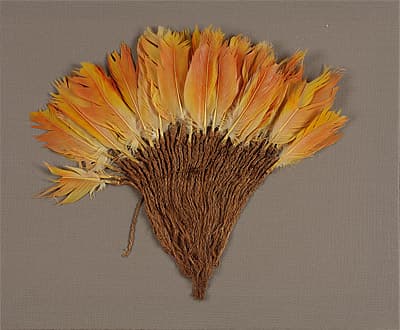
NAZCA culture South coast 100 – 700 AD
Plume 100-700 AD feathers and vegetable fibre51.0 (h) x 46.0 (w) cm Museo Oro del Perú, Lima Photograph: Daniel Giannoni
Birds represent the upper world, the heavens, since the sky is their domain. Brilliant feathers from parrots were used for cloaks, headdresses and decorations for the Peruvian elite. Feathers were traded between the tropics and the highlands or coasts. Yellow plumes—coveted because the colour stood for the sun, gold and the gods— were created by tapirage: plucking a live bird and rubbing its skin with toad secretions and plant dye. The new feathers grew out yellow and soft pink.
Birds represent the upper world, the heavens, since the sky is their domain. Brilliant feathers from parrots were used for cloaks, headdresses and decorations for the Peruvian elite. Feathers were traded between the tropics and the highlands or coasts. Yellow plumes—coveted because the colour stood for the sun, gold and the gods— were created by tapirage: plucking a live bird and rubbing its skin with toad secretions and plant dye. The new feathers grew out yellow and soft pink.
Birds represent the upper world, the heavens, since the sky is their domain. Brilliant feathers from parrots were used for cloaks, headdresses and decorations for the Peruvian elite. Feathers were traded between the tropics and the highlands or coasts. Yellow plumes—coveted because the colour stood for the sun, gold and the gods— were created by tapirage: plucking a live bird and rubbing its skin with toad secretions and plant dye. The new feathers grew out yellow and soft pink.

